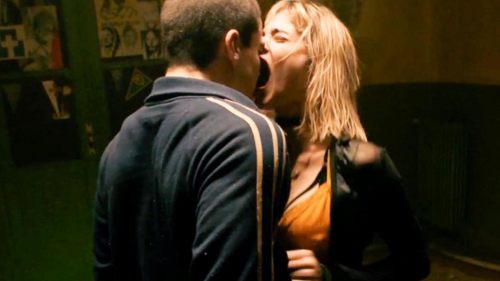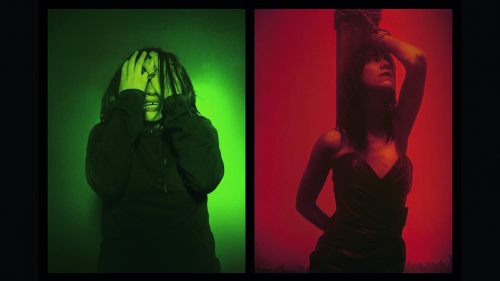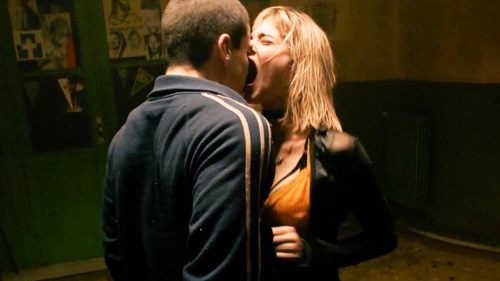CLIMAX: Gaspar Noé‘s Infinite Rave-Up
Climax is almost here. Get your tickets now!
It starts with a beat.
The simple 4/4 disco beat of Cerrone’s “Supernature”, remade harder and faster, its lyrics of chemically-deranged beasts putting humanity on trial stripped away. As the melody drops we find ourselves in an abandoned school in France in the winter of 1996, lost in music and the whirling bodies of a troupe rehearsing the routine they’ve spent two days creating. In groups and singly they gyrate, contort and strut, come together and break apart, all the while unified by that pervasive beat, and so Climax reveals itself to be something entirely unexpected: Gaspar Noé’s dance movie.
Not that it’s a disco movie in the Saturday Night Fever vein, drawing instead on the dance music that came later. Disco was declared dead a couple of years after John Travolta strutted his stuff in a pair of white bellbottoms, amid a backlash driven by fans of rock music and the rise of punk, although it never truly went away. Still popular in Europe, disco absorbed local influences and eventually made its way back across the Atlantic to inform the nascent house scene in a cross-fertilisation which in turn was exported back to Europe and gave rise to the underground dance parties which came to be known as raves. They’re still held today.
Climax brings that European rave scene to life, its characters like-minded souls immersed in music and their own improvisational dance while still locked together by the rhythm. It’s a primal, tribal thing and even without the influence of party drugs the dancers seem to enter a euphoric state, feeding off the energy they build together in dances born of the streets rather than the stage or studio: the elaborate poses of voguing, the arm and floor work of waacking, the pop-and-lock of krumping. Even when their dances intersect they retain their individuality, the troupe’s diversity in gender, colour and sexuality reflected in outfits ranging from party frocks to boob tubes, simple t-shirts to tracksuit tops, skirts to skin-tight jeans, usefully making them readily distinguishable.
In all of this, Noé is drawing on remembrances of his own clubbing days and their soundtrack, highlighted at a key point of the routine as Daddy (Kiddy Smile) leaves the decks and makes his way down to the floor. Noé pushes in and we watch from above as Daddy performs his own solo routine at the centre of the group, drawing the dancers toward him from left and right before controlling their collective dance and driving them to reach new heights. The metaphor is clear: Daddy is directing the troupe much as Noé is DJing the movie.
Full of electronic and avant-garde music, the French-Argentine director’s films broadly fall under the scope of a cinema of the body identified as part of the New French Extremity, itself a loose grouping of films which use unflinching depictions of sex and violence shot through with pervasive nihilism to explore the disintegration of social norms, the body and the self. It fuses elements of cinematic genres as diverse as French New Wave, surrealism, horror and exploitation, reflecting the cultural diversity and sense of fierce artistic freedom behind the Godard-esque block capital caption that announces Climax as A FRENCH FILM AND PROUD OF IT.
In this context, a dance troupe immediately seems like fertile ground for Noé’s feverish exploration: few other groups of people are as acclimated to becoming this physically, socially and artistically intimate within minutes of meeting and more than anything Noé’s camera (he again served as his own operator for the majority of the fifteen-day shoot) loves the human body, especially when in motion. At the same time, Noé knows exactly when to reign in his signature shooting style, simply framing the entire troupe in a seeming homage to Busby Berkeley’s elaborate dance numbers with their scores of dancers arranged in ever-changing geometric patterns.
Climax finds its geometry within the bodies of its dancers but also echoes Berkeley’s “parade of faces” technique of giving each their moment to shine as they appropriate the central space for personality-driven solo set pieces: choreographer Selva (Sofia Boutella) is the one who sets it all in motion and spurs the troupe on, David (Romain Guillermic) expresses his wannabe alpha-male status, Dom (Mounia Nassangar) demonstrates her assertiveness, Psyche (Thea Carla Schøtt) is birthed by jazz hands to steal the show, Lou (Souheila Yacoub) displays a range of more conventional moves and Lea (Lea Vlamos) dances sensuously in a column of light.
All these moments are clues that will pay off later in plot developments, visual references and reinterpreted dances: the movie’s entire narrative is encoded in this five minute sequence, shot in a single take which itself segues into a different kind of dance as, through the camera’s eye, we walk through and around the post-rehearsal party with the characters. They drink and dance for the sheer joy of it, share confidences and fears, brag and bitch to one another and reveal the depths and complexities of their relationships, Noé’s camera at its most still when his characters are at their most open, a visual grammar that continues as it rotates in sympathy with the turntable through a pumping mid-film credits sequence.
Being a Gaspar Noé movie, Climax was never going to be one long party, but on the other side of that false ending it doesn’t seek to recreate the notorious brutality of Irréverslble and unbridled sexuality of Love, concerning itself with the mind rather than the flesh. In hitherto unseen spaces the dance plays out anew, made strange and ugly by the malevolent energy spilling from the rehearsal room, Noé unleashing his trademark kaleidoscopic swirling camerawork as he stalks among bodies writhing to rhythms of their own, the blistering musical experience of Climax mutating into pure cinema.
Through it all, the beat goes on.



